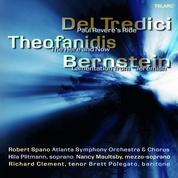|
You are reading the older HTML site
Positive Feedback
ISSUE
24
Two World Premiere Choral Recordings: Paul Revere’s Ride, The Here and Now,
plus Lamentation
Del Tredici, Paul Revere’s Ride/Theofanidis, The Here and Now/Bernstein, Lamentation. Atlanta Symphony Orchestra and Chorus, Robert Spano, Music Director, Norman Mackenzie, Director of Choruses (Telarc CD 80638/SACD 60638) There is much more to say about this release than space permits. It features two world-premiere recordings. The Bernstein symphony is the only composition here that is not in its infancy. It was written in the early 1940s, while Bernstein was in his mid-twenties. The last movement was subtitled "Lamentation," and because the symphony is usually referred to as the Jeremiah Symphony, the last movement is often called "Jeremiah’s Lamentation" and performed separately, as it is here. It is scored for soprano with full orchestra, but without chorus. In all of the selections, the soprano is Hila Plitmann, a favorite of composer David Del Tredici. Plitmann seems very comfortable in all three pieces, with a clear and powerful presentation that is thankfully free of excessive vibrato. Composer Christopher Theofanidis—now famous for his prize-winning composition, Rainbow Body—was commissioned by Robert Spano to produce a new choral work. The resulting composition, The Here and Now, revolves around the mystic philosopher, poet, and teacher Rumi. Rumi met the wise man Shams, an eccentric wandering dervish, and the two were inseparable until Shams disappeared and the grieving Rumi developed a habit of constantly turning around in a trance. His students have continued this habit to the present time, and are thus known as the Whirling Dervishes. Theofanidis used English translations of Rumi’s poems to create this work, which is comprised of thirteen short movements. I thoroughly enjoyed this composition. The first track runs right into the second without pause. The opening is impressively bold, with rich, full-bodied scoring recorded in outstanding, full-range sound. Choral passages abound in tracks 3 and 4, while 5 is a narrative containing some very exotic and melodic music. Track 6 is subtly exotic at the start, then the mainly female sections of the chorus enter. Eventually, a hushed male chorus is added, along with percussion. There is a tremendous amount of variety in this outstanding composition, yet it flows smoothly. The choral sections are female-only at times, male-only at other times, and sometimes mixed. They frequently hush down to pianissimo, then explode in brilliant fortissimos. The entire group of hundred-plus musicians is heard clearly, with great power from the lower midrange down to the midbass. Audiophiles will rejoice at the sound, although there are a few spots of edginess in fortissimo passages. Paul Revere’s Ride, a recent composition by David Del Tredici, the father of Neo-Romanticism, has a very different background. The composition retells Longfellow’s famous "Landlord Tale," better known by its subtitle, "Paul Revere’s Ride." The Del Tredici work is a piece of imaginative storytelling, with imaginative sound effects. The story is partly told by the soprano, and partly by the rich and varied orchestral score. Here again, the hundred-plus group of musicians is given an entertaining workout, in which the percussionists really get to show off. The recording captures everything in great, unforced detail. The perspective is row D through H most of the time, and there is rarely any undue highlighting. I give this piece my highest recommendation, for audiophiles and music lovers. The music is very accessible and melodic—no atonal harshness here. In addition to the instrumentalists, the chorus of almost two hundred performs admirably. The featured soloists are soprano Hila Plitman, mezzo-soprano Nancy Maultsby, tenor Richard Clement, and baritone Brett Polegato. I will go out on a limb and predict that within the next few years, one or both of these outstanding new compositions will gain the reputation of being among the best of the early twenty-first century. Further out on that limb, I also predict that this recording will become the standard by which others will be judged for some time to come. Technically, it is somewhere between outstanding and superb. It offers the vivid clarity that many (if not most) music lovers appreciate and that some audiophiles live for. As usual, the excellent CD-only disc is slightly but definitely surpassed by the SACD release. Please remember that if we do not support the efforts of companies that make the highest-quality recordings (by purchasing them), they will cease to exist!
|

